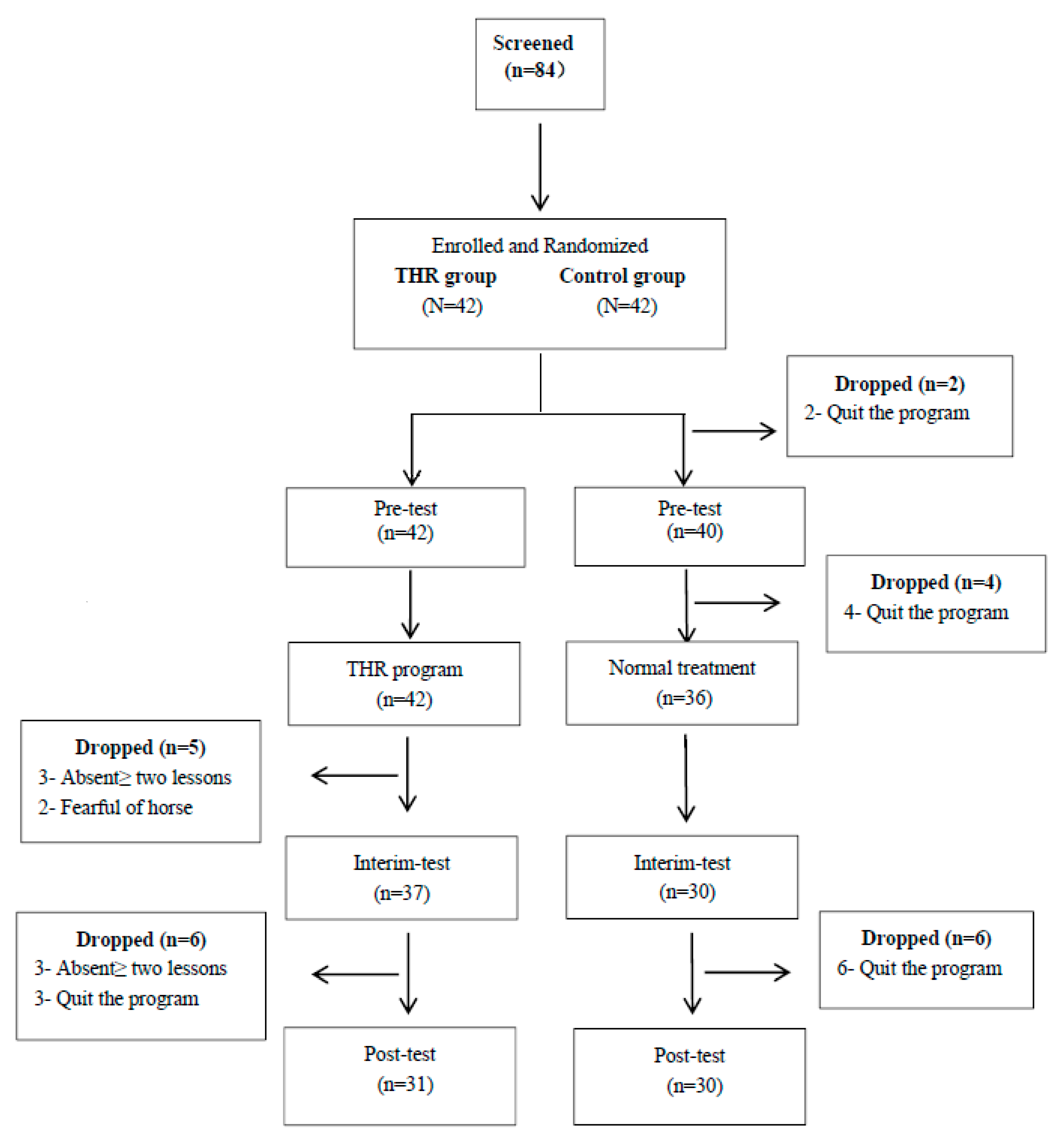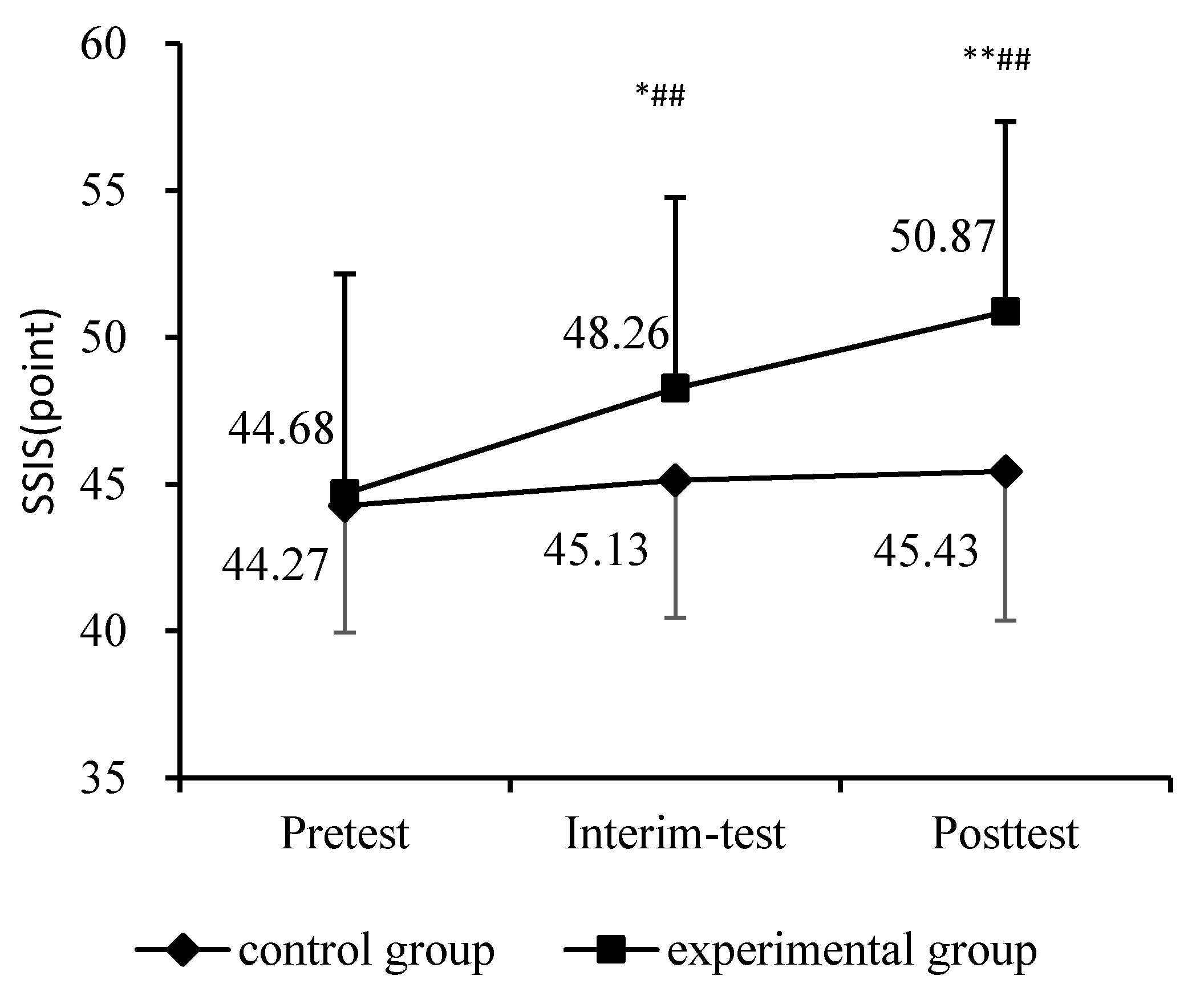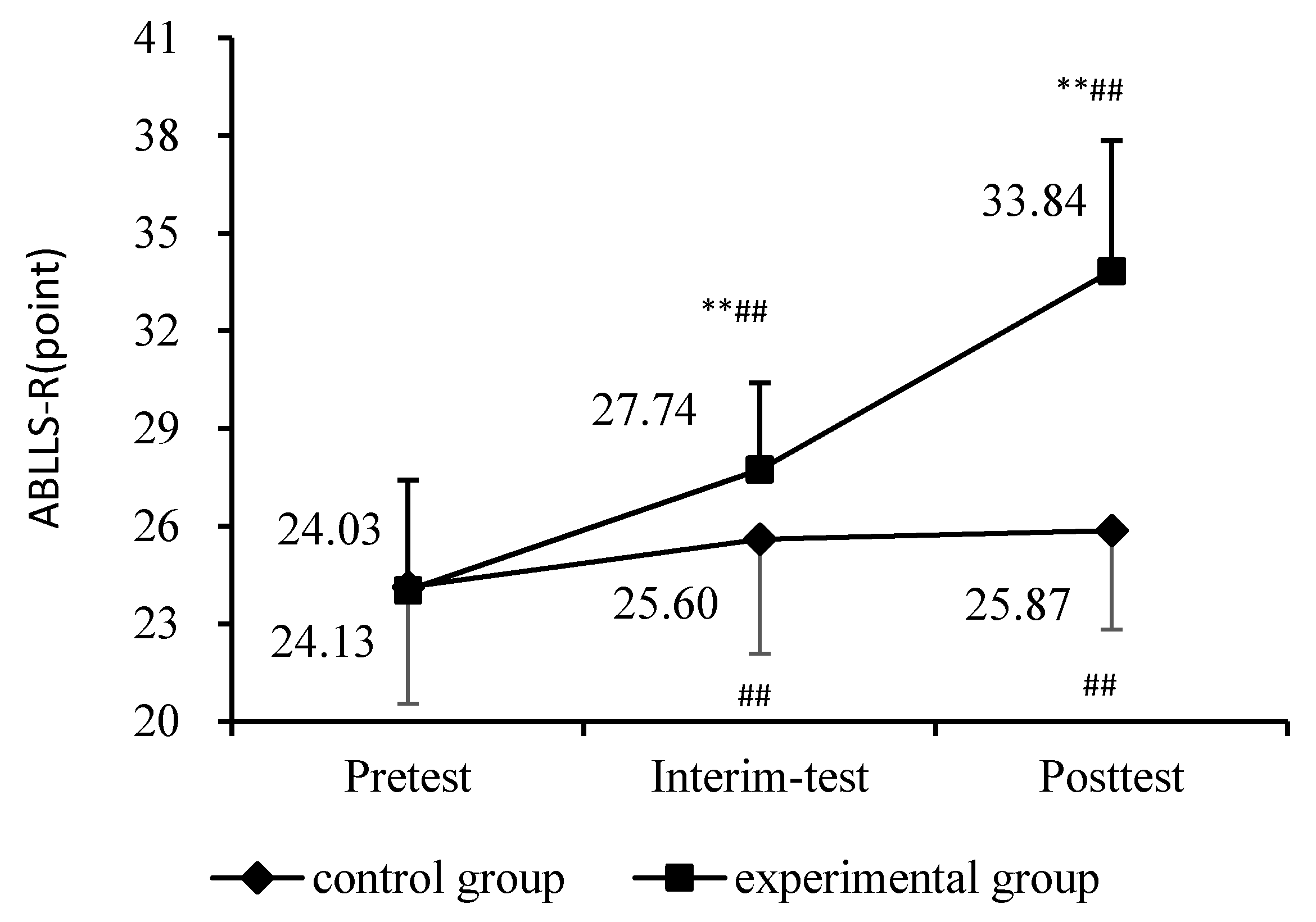Effects of a Therapeutic Horseback Riding Program on Social Interaction and Communication in Children with Autism
Abstract
1. Introduction
2. Materials and Methods
2.1. Participants
2.2. Procedures
2.3. Measurements
2.4. Therapeutic Horseback Riding Program (THR Program)
2.5. Data Collection and Analysis
3. Results
3.1. The Effects of the Therapeutic Horseback Riding Program on Social Interaction
3.1.1. The Effects of the Therapeutic Horseback Riding Program on the SSIS
3.1.2. The Effects of the Therapeutic Horseback Riding Program on the ABLLS-R
3.2. The Effects of the Therapeutic Horseback Riding Program on Communication
4. Discussion
5. Conclusions
Author Contributions
Funding
Institutional Review Board Statement
Informed Consent Statement
Data Availability Statement
Conflicts of Interest
References and Note
- American Psychiatric Association. Diagnostic and Statistical Manual of Mental Disorders, 5th ed.; American Psychiatric Association: Washington, DC, USA, 2013. [Google Scholar]
- CDC Centers for Disease Control and Prevention. Available online: https://www.cdc.gov/ncbddd/autism/data.html (accessed on 5 March 2021).
- Rogers, S.J.; Vismara, L.A.; Colombi, C. The Early Start Denver model parent coaching manual. 2008. Manuscript in preparation.
- Warren, Z.; McPheeters, M.L.; Sathe, N.; Foss-Feig, J.H.; Glasser, A.; Veenstra-Vanderweele, J. A systematic review of early intensive intervention for autism spectrum disorders. Pediatrics 2011, 127, e1303–e1311. [Google Scholar] [CrossRef]
- O’Haire, M.E. Animal-assisted intervention for autism spectrum disorder: A systematic literature review. J. Autism Dev. Disord. 2013, 43, 1606–1622. [Google Scholar] [CrossRef] [PubMed]
- Fine, A.H. Animals and therapists: Incorporating animals in outpatient psychotherapy. In Handbook on Animal-Assisted Therapy: Theoretical Foundations and Guidelines for Practice; Fine, A.H., Ed.; Academic Press: New York, NY, USA, 2000; pp. 179–211. [Google Scholar]
- O’Haire, M.E. Companion animals and human health: Benefits, challenges, and the road ahead. J. Vet. Behav. Clin. Appl. Res. 2010, 5, 226–234. [Google Scholar] [CrossRef]
- Morrison, M.L. Health benefits of animal-assisted interventions. Complement. Health Pract. Rev. 2007, 12, 51–62. [Google Scholar] [CrossRef]
- Wells, D. The effects of animals on human health and well-being. J. Soc. Issues 2009, 65, 523–543. [Google Scholar] [CrossRef]
- Friedmann, E.; Son, H. The Human Companion Animal Bond: How Humans Benefit. Vet. Clin. Small Anim. 2009, 39, 293–326. [Google Scholar] [CrossRef]
- All, A.C.; Loving, G.L.; Crane, L.L. Animals, horseback riding, and implications for rehabilitation therapy. J. Rehabil. 1999, 65, 49–57. [Google Scholar]
- Lessick, M.; Shinaver, R.; Post, K.M.; Rivera, J.E.; Lemon, B. Therapeutic horseback riding: Exploring this alternative therapy for women with disabilities. Association of Women′s Health. Obstet. Neonatal Nurses Lifelines 2004, 8, 46–53. [Google Scholar]
- Bass, M.; Duchowny, M.; Llabre, C. The effect of therapeutic horseback riding on social functioning in children with autism. J. Autism Dev. Disord. 2009, 39, 1261–1267. [Google Scholar] [CrossRef]
- Gabriels, R.L.; Agnew, J.A.; Holt, K.D.; Shoffner, A.; Zhaoxing, P.; Ruzzano, S.; Mesibov, G. Pilot study measuring the effects of therapeutic horseback riding on school-age children and adolescents with autism spectrum disorders. Res. Autism Spectr. Disord. 2012, 6, 578–588. [Google Scholar] [CrossRef]
- Ward, S.C.; Whalon, K.; Rusnak, K.; Wendell, K.; Paschall, N. The association between therapeutic horseback riding and the social communication and sensory reactions of children with autism. J. Autism Dev. Disord. 2013, 43, 2190–2198. [Google Scholar] [CrossRef] [PubMed]
- Winchester, P.; Kendall, K.; Peters, H.; Sears, N.; Winkley, T. The effect of therapeutic horseback riding on gross motor function and gait speed in children who are developmentally delayed. Phys. Occup. Ther. Pediatr. 2002, 22, 37–50. [Google Scholar] [CrossRef] [PubMed]
- Schultz, P.N.; Remick-Barlow, G.A.; Robbins, L. Equine-assisted psychotherapy: A mental health promotion/intervention modality for children who have experienced intra-family violence. Health Soc. Care Community 2007, 15, 265–271. [Google Scholar] [CrossRef] [PubMed]
- Silkwood-Sherer, D.J.; Killian, C.B.; Long, T.M.; Martin, K.S. Hippotherapy: An intervention to habilitate balance deficits in children with movement disorders: A clinical trial. Phys. Ther. 2012, 92, 707–717. [Google Scholar] [CrossRef]
- Lechner, H.E.; Kakebeeke, T.H.; Hegemann, D.; Baumberger, M. The effect of hippotherapy on spasticity and on mental well-being of persons with spinal cord injury. Arch. Phys. Med. Rehabil. 2007, 88, 1241–1248. [Google Scholar] [CrossRef] [PubMed]
- Christon, L.; Mackintosh, V.; Myers, B. Use of complementary and alternative medicine (CAM) treatments by parents of children with autism spectrum disorders. Res. Autism Spectr. Disord. 2010, 4, 249–259. [Google Scholar] [CrossRef]
- Thomas, K.C.; Morrissey, J.P.; McLaurin, C. Use of autism-related services by families and children. J. Autism Dev. Disord. 2007, 37, 818–829. [Google Scholar] [CrossRef]
- Davis, T.N.; Scalzo, R.; Butler, E.; Stauffer, M.; Farah, Y.N.; Perez, S.; Coviello, L. Animal-assisted interventions for children with autism spectrum disorder: A systematic review. Educ. Train. Autism Dev. Disabil. 2015, 50, 316–329. [Google Scholar]
- Harris, A.; Williams, J. The impact of a horse riding intervention on the social functioning of children with autism spectrum disorder. Int. J. Environ. Res. Public Health 2017, 14, 76. [Google Scholar] [CrossRef]
- American Psychiatric Association. Diagnostic and Statistical Manual of Mental Disorders, 6th ed.; American Psychiatric Association: Washington, DC, USA, 2014. [Google Scholar]
- Gresham, F.M.; Elliott, S.N. Social Skills Improvement System: Rating Scales; Pearson Assessments: Bloomington, MN, USA, 2008. [Google Scholar]
- Partington, J.W. Assessment of Basic Language and Learning Skills, Revised (ABLLS-R); Partington Behavior Analysts: Pleasant Hill, CA, USA, 2006. [Google Scholar]
- O’Haire, M.E. Research on animal-assisted intervention and autism spectrum disorder, 2012–2015. Appl. Dev. Sci. 2017, 21, 200–216. [Google Scholar] [CrossRef]
- Gabriels, R.L.; Pan, Z.; Dechant, B.; Agnew, J.A.; Brim, N.; Mesibov, G. Randomized controlled trial of therapeutic horseback riding in children and adolescents with autism spectrum disorder. J. Am. Acad. Child Adolesc. Psychiatry 2015, 54, 541–549. [Google Scholar] [CrossRef] [PubMed]
- Kwon, S.; Sung, I.Y.; Ko, E.J.; Kim, H.S. Effects of therapeutic horseback riding on cognition and language in children with autism spectrum disorder or intellectual disability: A preliminary study. Ann. Rehabil. Med. 2019, 43, 279–288. [Google Scholar] [CrossRef] [PubMed]



| Variables | Experimental Group | Control Group | Total | p-Value | |
|---|---|---|---|---|---|
| Participants | 31 | 30 | 61 | F = 0.144 | 0.706 |
| Age, y, mean (SD) | 7.06(1.50) | 7.13(1.36) | 7.10(1.42) | t = −0.187 | 0.852 |
| Gender, n, M/F | 21/10 | 23/7 | 44/17 | =0.604 | 0.437 |
| Part | Time (min) | Content | Objective |
|---|---|---|---|
| 1. Warm-up activities | 15 | Participants get the visual tools (e.g., pictures, cards) themselves; stretching exercises, arm circles, trunk twists, lunge stretching; put on riding helmets and boots. | Obtain knowledge of horse and riding; social interaction and communication skills |
| 2. Riding and horsemanship skill instruction | 20 | Learn riding skills (e.g., hand walking the horse, mounting, dismounting, halting, steering, turning, and trotting) and horsemanship skills (e.g., lead and care for the horse); follow the riding instructors and try to practice and interact with the horse; build the participant-horse relationship with the assistance of the riding instructors and volunteers. | Riding skills; motor and balance ability; social skills |
| 3. THR exercises and activities | 15 | Engage in group exercises and activities on the horse (e.g., red light/green light, cup games, ball/cone games, letter games); reach to touch the horse’s ears or tail during riding. | Social interaction and communication skills |
| 4. Cool-down and reward activities | 10 | Groom the horses; feed and communicate with the horses (e.g., saying “thanks” and “goodbye”); put away equipment; high five/hugs to riding instructors, volunteers and parents; sing goodbye songs; get rewards (e.g., toys, snacks, stickers). | Rewards; feedback; social interaction and communication skills |
| Effect | F | Hypothesis df | Error df | Sig. | ES |
|---|---|---|---|---|---|
| Time | 38.847 | 2.000 | 58.000 | 0.000 | 0.573 |
| Time × group | 21.057 | 2.000 | 58.000 | 0.000 | 0.421 |
| Control Group | Experimental Group | Interaction | ||||||
|---|---|---|---|---|---|---|---|---|
| Pretest | Interim-Test | Post-Test | Pre-Test | Interim-Test | Post-Test | F(2,58) | Sig. | ES |
| 44.27 ± 4.31 | 45.13 ± 4.67 | 45.43 ± 5.08 | 44.68 ± 7.48 | 48.26 ± 6.51 *## | 50.87 ± 6.47 **## | 21.057 | 0.000 | 0.421 |
| Index | Control Group (n = 30) | Experimental Group (n = 31) | Interaction | ||||||
|---|---|---|---|---|---|---|---|---|---|
| Pre | Interim | Post | Pre | Interim | Post | F(2,58) | Sig. | ES | |
| Communication | 7.03 ± 1.54 | 7.17 ± 1.53 | 7.27 ± 1.46 | 6.71 ± 1.77 | 7.74 ± 1.55 ## | 8.48 ± 1.86 **## | 10.764 | 0.000 | 0.271 |
| Cooperation | 7.50 ± 1.41 | 7.57 ± 1.30 | 7.63 ± 1.22 | 7.55 ± 1.61 | 7.97 ± 1.66 # | 8.16 ± 1.73 ## | 1.532 | 0.225 | 0.050 |
| Assertion | 4.63 ± 1.10 | 4.80 ± 1.19 | 5.07 ± 1.39 # | 4.90 ± 1.58 | 5.23 ± 1.52 | 5.71 ± 1.47 ## | 1.212 | 0.305 | 0.040 |
| Responsibility | 5.87 ± 1.01 | 6.33 ± 1.21 # | 6.13 ± 1.17 | 6.23 ± 1.23 | 6.74 ± 1.21 ## | 7.00 ± 1.24 **## | 4.168 | 0.020 | 0.126 |
| Empathy | 5.70 ± 1.02 | 5.60 ± 1.10 | 5.53 ± 1.17 | 5.42 ± 1.29 | 5.68 ± 1.19 | 5.90 ± 1.27 ## | 3.399 | 0.040 | 0.105 |
| Engagement | 6.47 ± 1.14 | 6.90 ± 1.09 # | 7.03 ± 1.19 ## | 6.65 ± 1.45 | 7.52 ± 1.36 ## | 7.68 ± 1.51 ## | 1.429 | 0.248 | 0.047 |
| Self-control | 7.07 ± 1.53 | 6.77 ± 1.55 | 6.77 ± 1.55 | 7.23 ± 1.73 | 7.39 ± 1.75 | 7.94 ± 1.55 **## | 8.928 | 0.000 | 0.235 |
| Effect | F | Hypothesis df | Error df | Sig. | ES |
|---|---|---|---|---|---|
| Time | 62.915 | 2.000 | 58.000 | 0.000 | 0.684 |
| Time × group | 31.076 | 2.000 | 58.000 | 0.000 | 0.517 |
| Control Group | Experimental Group | Interaction | ||||||
|---|---|---|---|---|---|---|---|---|
| Pretest | Interim-Test | Posttest | Pretest | Interim-Test | Posttest | F(2,58) | Sig. | ES |
| 24.13 ± 3.59 | 25.60 ± 3.52 ## | 25.87 ± 3.05 # | 24.03 ± 3.38 | 27.74 ± 2.66 **## | 33.84 ± 4.00 **## | 31.076 | 0.000 | 0.517 |
| Index | CONTROL GROUP | Experimental Group | Interaction | ||||||
|---|---|---|---|---|---|---|---|---|---|
| Pre | Interim | Post | Pre | Interim | Post | F(2,58) | Sig. | ES | |
| Says please | 0.67 ± 0.48 | 0.80 ± 0.41 | 0.83 ± 0.38 | 0.52 ± 0.51 | 0.77 ± 0.43 ## | 0.94 ± 0.44 **## | 2.114 | 0.130 | 0.068 |
| Responds well when others start a conversation | 0.70 ± 0.53 | 0.83 ± 0.38 | 0.83 ± 0.46 | 0.84 ± 0.45 | 1.00 ± 0.37 # | 1.06 ± 0.51 ## | 0.501 | 0.608 | 0.017 |
| Speaks in appropriate tone of voice | 1.10 ± 0.66 | 1.10 ± 0.55 | 1.30 ± 0.47 # | 1.26 ± 0.44 | 1.35 ± 0.49 | 1.48 ± 0.51 ## | 0.310 | 0.735 | 0.011 |
| Take turns in conversations | 0.87 ± 0.57 | 0.77 ± 0.57 | 0.80 ± 0.55 | 0.74 ± 0.58 | 0.77 ± 0.56 | 0.81 ± 0.54 | 0.816 | 0.447 | 0.027 |
| Says thank you | 1.23 ± 0.43 | 1.23 ± 0.43 | 1.27 ± 0.45 | 1.23 ± 0.43 | 1.42 ± 0.50 # | 1.61 ± 0.56 *## | 4.076 | 0.022 | 0.123 |
| Makes eye contact when talking | 1.10 ± 0.31 | 1.17 ± 0.38 | 1.20 ± 0.41 | 1.10 ± 0.40 | 1.23 ± 0.50 # | 1.39 ± 0.56 *## | 1.942 | 0.153 | 0.063 |
| Uses gestures or body appropriately with others | 1.03 ± 0.18 | 1.07 ± 0.25 | 1.03 ± 0.32 | 1.03 ± 0.18 | 1.19 ± 0.40 ## | 1.19 ± 0.40 ## | 2.363 | 0.103 | 0.075 |
Publisher’s Note: MDPI stays neutral with regard to jurisdictional claims in published maps and institutional affiliations. |
© 2021 by the authors. Licensee MDPI, Basel, Switzerland. This article is an open access article distributed under the terms and conditions of the Creative Commons Attribution (CC BY) license (http://creativecommons.org/licenses/by/4.0/).
Share and Cite
Zhao, M.; Chen, S.; You, Y.; Wang, Y.; Zhang, Y. Effects of a Therapeutic Horseback Riding Program on Social Interaction and Communication in Children with Autism. Int. J. Environ. Res. Public Health 2021, 18, 2656. https://doi.org/10.3390/ijerph18052656
Zhao M, Chen S, You Y, Wang Y, Zhang Y. Effects of a Therapeutic Horseback Riding Program on Social Interaction and Communication in Children with Autism. International Journal of Environmental Research and Public Health. 2021; 18(5):2656. https://doi.org/10.3390/ijerph18052656
Chicago/Turabian StyleZhao, Mengxian, Shihui Chen, Yonghao You, Yongtai Wang, and Yanjie Zhang. 2021. "Effects of a Therapeutic Horseback Riding Program on Social Interaction and Communication in Children with Autism" International Journal of Environmental Research and Public Health 18, no. 5: 2656. https://doi.org/10.3390/ijerph18052656
APA StyleZhao, M., Chen, S., You, Y., Wang, Y., & Zhang, Y. (2021). Effects of a Therapeutic Horseback Riding Program on Social Interaction and Communication in Children with Autism. International Journal of Environmental Research and Public Health, 18(5), 2656. https://doi.org/10.3390/ijerph18052656







